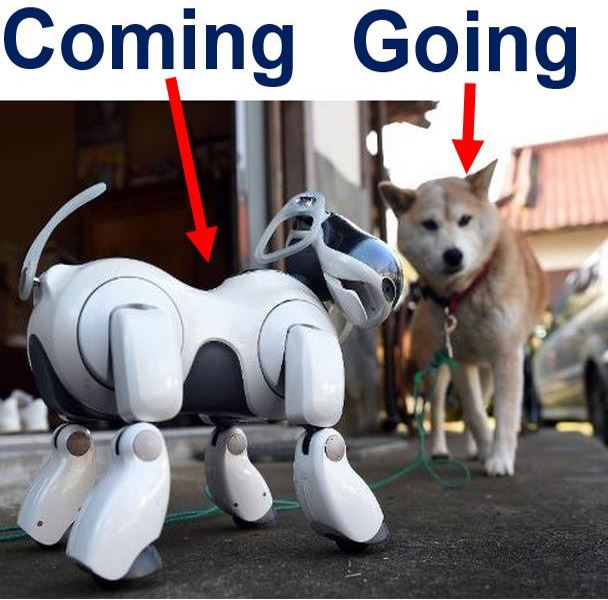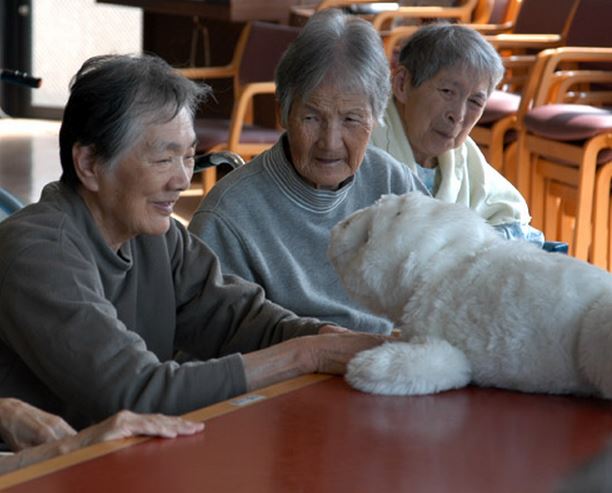The growth in high-density city living and our infatuation with high tech products mean that robopets will start replacing real animals within the next decade, says Dr. Jean-Loup Rault, an animal welfare researcher at the University of Melbourne, Australia.
The prospect of a world filled with robopets and virtual mascots is not as far-fetched as people may think, says Dr. Rault, who works at the Faculty of Veterinary & Agricultural Sciences.
Dr. Rault authored a paper in the academic journal Frontiers of Veterinary Science (citation below) in which he argues that pets will soon become a luxury very few people will be able to afford in an overpopulated world.

Are humans about to replace their faithful, loving best friend with a robot?
Animals will give way to chips and circuits
Our desire for ‘best friend companionship’ will come from chips and circuits that mimic the real thing, he forecasts.
Dr. Rault said:
“It might sound surreal for us to have robotic or virtual pets, but it could be totally normal for the next generation. It’s not a question of centuries from now.”
“If 10 billion human beings live on the planet in 2050 as predicted, it’s likely to occur sooner than we think. If you’d described Facebook to someone 20 years ago, they’d think you were crazy. But we are already seeing people form strong emotional bonds with robot dogs in Japan.”
“Pet robotics has come a long way from the Tamagotchi craze of the mid-90s. In Japan, people are becoming so attached to their robot dogs that they hold funerals for them when the circuits die.”
After discovering there is very little information on how technology might impact our relationships with animals in years to come, Dr. Rault decided to carry out research on the topic.
Dr. Rault said:
“You won’t find a lot of research on pet robotics out there, but if you Google robot dogs, there are countless patents. Everyone wants to get ahead of this thing because there is a market and it will take off in the next 10 to 15 years.”
Relying on robots for companionship?
He warns, however, that the advent of robotic pets is a double-edged sword. For people with pet allergies they will be a godsend, but he and many other people wonder about the ethics of relying on a robot for companionship. In this context, ‘ethics’ refers to whether it is ‘right or wrong’.

PARO is a robot modeled after a baby harp seal. It is covered with soft artificial fur to make people feel comfortable, as if they are touching a real animal. (Image: parorobots.com)
Scientists have seen that robots can trigger human emotions.
Dr. Rault commented:
“If artificial pets can produce the same benefits we get from live pets, does that mean that our emotional bond with animals is really just an image that we project on to our pets?”
Dr. Rault, who specialises in animal welfare, wonders whether a surge in popularity of disposable ‘fake’ robot pets might lead to a shift on how humans treat animals.
“Of course we care about live animals, but if we become used to a robotic companion that doesn’t need food, water or exercise, perhaps it will change how humans care about other living beings,” Dr. Rault said.
Artificial intelligence may help create super pets
As artificial intelligence advances, it is possible that future robot pets may be able to learn to think and respond on their own.
Dr. Rault said:
“When engineers work on robotic dogs, they work on social intelligence, they address what people need from their dogs: companionship, love, obedience, dependence.”
“They want to know everything about animal behaviour so they can replicate it as close as possible to a real pet.”
Making robotic cats is a little more difficult, because they would need to be unpredictable, Dr. Rault concluded.
Facts about robopets
The most well-known commercially available robotic pet dog is Sony’s AIBO. Kids treat the robot as if it were a real, living dog. According to recent research, AIBO owners tend to give the robot a status of its own, which is currently somewhere between an object and an animal.
Paro, a robotic baby seal, is being used in the United States therapeutically with medical patients.
There are several virtual worlds where you can own animals. HappyFarm, for example, at its peak had 23 million users each day.
Over 76 million Tamagotchis were sold globally.
A demonstration in March in Austin, Texas, led by computer engineer Adam Mason, warned about robots, and expressed concern that if humans are not careful, civilization and possibly our own survival could be under serious threat from robots and artificial intelligence. Many of the protestors were computer engineers.
Citation: “Pets in the digital age: live, robot, or virtual?“ Jean-Loup Rault. Frontiers of Veterinary Science. Published 7 May, 2015. DOI: 10.3389/fvets.2015.00011.
Video – Artificial Intelligence
Roboticists and computer scientists say that for robots to take over as pets, they will need to have AI. AI or Artificial Intelligence refers to programs engineers created that make computers, robots, and other devices ‘intelligent.’ In other words, they designed them to mimic how human beings think and behave.
